Research Trends on Antimicrobial Peptides in Aquaculture: A Thematic and Bibliometric Analysis
Abstract
The emergence of antimicrobial resistance has become a critical concern in aquaculture. Antimicrobial peptides (AMPs), a class of small, natural or synthetic peptides that protect hosts from microbial infections, offer a promising alternative to traditional antibiotics. To evaluate the current status and research trends of AMP in aquaculture, we conducted a bibliometric analysis of 1956 publications (from 1990 to 2024) retrieved from the Web of Science, using the Bibliometrix R package and CiteSpace. The results showed that the study of AMPs in aquaculture has entered a phase of rapid development since 2015, marked by exponential growth of publications. Chinese research institutions and scholars have played a leading role, contributing over one-third of all publications. However, their involvement in multicountry collaborations remains significantly lower than that of other countries, highlighting the need for enhanced international collaboration. Thematic evolution analysis based on keywords reveals a shift in research focus from gene cloning and antibacterial activities to mechanisms of action and practical applications. Overall, this bibliometric study offers a comprehensive overview of the current landscape, research hotspots, and future directions of AMP research in aquaculture, providing valuable insights for advancing the field.
1. Introduction
Aquaculture is one of the world’s fastest-growing food production sectors, yielding 185.4 million tons of aquatic animals in 2022 [1]. Contributing nearly 17% of global animal-source protein, aquaculture continues to expand rapidly [2]. However, infectious diseases remain a major challenge, causing an estimated USD 6 billion in annual economic losses [3]. Traditionally, aquaculture has relied heavily on antibiotics and other chemical treatments to combat infectious disease. However, the extensive use of these agents raises concerns regarding environmental contamination and the emergence of antibiotic-resistant bacteria [4]. To address these issues and mitigate the rise of antibiotic resistance, the development of alternative antibacterial strategies is crucial. Among these, antimicrobial peptides (AMPs) have garnered significant attention as a promising and sustainable alternative [5–7].
AMPs are a class of small peptides naturally produced by nearly all living organisms, functioning as a first line of defense against microbial infections [5]. They typically disrupt bacterial cell membranes by neutralizing their charge and penetrating the lipid bilayer, ultimately leading to cell death and reduced likelihood of resistance development [8–12]. In addition to their well-documented antibacterial activity, AMPs possess a wide range of biological activities, including antiviral and antifungal properties, as well as immunomodulatory effects, such as chemotactic activity, promotion of angiogenesis, and enhancement of leukocyte/monocyte activation and differentiation [13–16]. AMPs also influence proinflammatory cytokines expression, further underscoring their multifunctionality [8, 9, 17]. As evolutionarily conserved immune components in insects, plants, animals, and humans, AMPs are typically nontoxic to the host, target pathogens directly, exhibit broad-spectrum activity, and are less likely to promote resistance, making them excellent candidates for application in aquaculture [18–22].
In recent years, a growing number of AMPs have been identified from aquatic animals [23–25], and many are being explored as antibiotic alternatives for controlling infections and promoting growth in aquaculture [26–31]. Existing reviews have discussed the structural characteristics, mechanisms of action, immune defense roles, and additional biological functions of fish AMPs, including antioxidant and antitumor activities [23, 32–35]. Others have highlighted potential applications in vaccine adjuvants, nutraceuticals, food preservation, and human health [20, 32]. These reviews have been invaluable in synthesizing knowledge about aquatic AMPs. However, as the field has expanded in recent decades, with a growing body of literature and divergent research foci, comprehensive assessments are needed to understand broader research dynamics, such as publication trends, international collaborations, and thematic shifts over time. For these purposes, bibliometric analysis offers a useful complementary approach [36].
Bibliometric analysis is a quantitative research method used to evaluate research output, citation networks, and patterns of author collaborations [37]. Unlike systematic or scoping reviews, it employs statistical methods and visualization tools to analyze large volumes of bibliographic data [38, 39]. By extracting data from titles, abstracts, authors, affiliations, keywords, and citation networks, bibliometric studies can reveal key trends, influential works, and knowledge gaps in a given field [39, 40]. In recent years, such analyses have become widely applied to access scientific progress. For example, Liu et al. [41] used Web of Science data to study antibiotic resistance in Acinetobacter baumannii from 1991 to 2019, identifying key research trends and potential treatment strategies. Jangid et al. [42] analyzed global research on carbapenem-resistant A. baumannii (CRAB) from 1996 to 2023, identifying research gaps and advocating for advanced diagnostics and combination therapies, including bacteriophage and immunomodulatory approaches. Liang et al. [43] explored AMP research for drug-resistant bacteria, finding a growing focus on practical applications, drug delivery optimization, and the search for novel AMPs.
Despite increasing interest in AMPs within aquaculture, no comprehensive bibliometric analysis has yet been conducted in this field. To address this gap, the present study analyzes publications in this field over the past 34 years (from 1990 to 2024), identifying key contributors, thematic trends, and emerging directions. This study aims to provide a valuable reference for guiding the future of AMP research in aquaculture.
2. Materials & Methods
2.1. Search Strategy and Data Extraction
Literature data were retrieved from the ISI Web of Science Core Collection, curated databases: Science Citation Index Expanded (1980–present), Social Sciences Citation Index (2001–present), Conference Proceedings Citation Index–Science (1990–present), Current Chemical Reactions (1985–present), and Index Chemicus (1993–present). The following advanced search strategy was applied: TS = (“Antimicrobial Peptide ∗” OR “Antibacterial Peptide ∗” OR “host defense peptide ∗”) AND TS = (“aquaculture” OR “aquatic animals” OR “fish” OR “shellfish” OR “shrimp ∗” OR “mussels” OR “crabs”). The asterisk ( ∗) serves as a wildcard character, representing any character that could follow. The search was refined to include only articles and reviews, excluding editorials, letters, books, corrections, and proceedings papers. Only publications written in English and published up to July 2024 were included. A total of 2444 records were initially retrieved. Manual screening was then conducted to exclude studies that were not directly relevant to the research topic [39]. The exclusion criteria were as follows: i) publications classified as abstracts or redundant literature, ii) articles focused on nonaquatic organisms (e.g., terrestrial animals and humans) and iii) studies primarily discussing synthetic antibiotics or nonpeptide antimicrobial agents. After reviewing the abstracts of each article for relevance, the final dataset consisted of 1956 publications. Corresponding raw datasets and annotated R scripts for data processing and visualization are provided in the supporting infromation (Supporting Information S1). A flowchart describing the literature selection and analysis process is shown in Figure 1.

2.2. Data Analysis
The key metadata were extracted, including keywords, publication type, annual publication, citation count, citation density (the average number of citations per year, and authorship (authors’ countries and institutions). These data were analyzed and visualized using the R package “bibliometrix” (version 4.3.0) (https://www.bibliometrix.org) (Supporting Information S1) [44]. Journal quartiles and impact factors were obtained from Journal Citation Reports (JCR) 2023. Collaborative networks between countries, institutions, journals, and authors, as well as co-citation of keyword clusters, were visualized using the bibliometrix package [44]. Reviews articles were excluded from analyses of empirical research productivity and citation trends to avoid citation bias [39].
A thematic map based on author keywords was conducted using the Biblioshiny web interface of the bibliometrix package. To improve accuracy, synonyms (e.g., “antibacterial peptide,” “antibacterial peptides,” and “AMP”) were manually consolidated prior to analysis. The top 250 keywords were included in the clustering analysis, with a minimum frequency of five. Each thematic cluster was assigned up to three representative keywords.
To identify research hotspots and frontiers, Citespace (version 6.2 R4) [45] was used to detect keyword bursts. The following parameters were applied: the time slicing was set as “1990–2024”, with the year per slice set to “1”; the term source was set as “author keywords”; the node type was set as “Choose 1 at a time”; the pruning methods was set as “Pruning sliced networks, Pruning the merged network, Minimum Spanning Tree”; the visualization map was set to “cluster view-static, show merged network”. Burst detection parameters: γ (0, 1) was set to 0.5, and the minimum duration was set to 3. A total of 86 keywords with significant burst strength were identified, and the top 60 were retained for final visualization.
All statistical analyses were performed using R (version 4.4.1). Spearman rank correlation coefficients were calculated using the stats package (version 4.4.1). The following packages were used for data visualization: ggplot (3.5.1), ggpubr (0.6.0), and ggmap (3.5.1).
3. Results
3.1. General Landscape of Included Documents on Aquatic AMPs
A total of 1956 records related to aquatic AMPs, published between 1990 and 2024, were retrieved. These publications were distributed across 340 journals. The top three most influential journals in this domain were Fish & Shellfish Immunology (n = 551), Developmental and Comparative Immunology (n = 198), and Aquaculture (n = 110) (Table 1).
| Source | Publications | JCR | IF | 5YIF |
|---|---|---|---|---|
| Fish and Shellfish Immunology | 551 | Q1 | 4.1 | 4.2 |
| Developmental and Comparative Immunology | 198 | Q1 | 2.7 | 2.8 |
| Aquaculture | 110 | Q1 | 3.9 | 4.4 |
| Frontiers in Immunology | 56 | Q1 | 5.7 | 6.8 |
| Marine Drugs | 54 | Q1 | 4.9 | 5.2 |
| Molecular Immunology | 52 | Q2 | 3.2 | 3.6 |
| PLoS One | 28 | Q1 | 2.9 | 3.3 |
| Scientific Reports | 26 | Q1 | 3.8 | 4.3 |
| Probiotics and Antimicrobial Proteins | 24 | Q1 | 4.5 | 5 |
| Peptides | 22 | Q2 | 2.8 | 2.9 |
| Marine Biotechnology | 20 | Q1 | 2.6 | 2.8 |
| Comparative Biochemistry and Physiology B-Biochemistry and Molecular Biology | 19 | Q1 | 1.9 | 2 |
| Aquaculture Reports | 18 | Q1 | 3.2 | 3.5 |
| International Journal of Peptide Research and Therapeutics | 18 | Q4 | 2 | 1.8 |
| Journal of Biological Chemistry | 17 | Q2 | 4 | 4.4 |
| Journal of Fish Diseases | 17 | Q1 | 2.2 | 2.4 |
| International Journal of Molecular Sciences | 17 | Q1 | 4.9 | 5.6 |
| Aquaculture Research | 16 | Q2 | 1.9 | 2.2 |
| Journal of Immunology | 12 | Q2 | 3.6 | 4.2 |
| BMC Genomics | 12 | Q2 | 3.5 | 4.1 |
- Note: JCR and IF were curated from Web of Science of 2024.
- Abbreviations: 5YIF, 5-year journal impact factor; IF, impact factor; JCR, Journal Citation Reports.
Among the dataset, 1678 (85.8%) were original research articles, and 278 (14.2%) were review papers. Polynomial regression analysis revealed a strong correlation between publication year and annual output, with coefficients of determination (R2) of 0.9263 for all outputs, 0.9270 for articles, and 0.7943 for reviews (Figure 2).
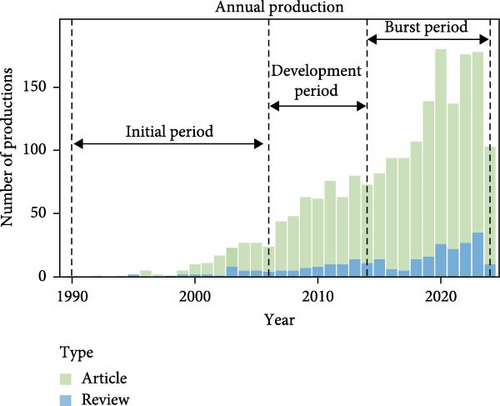
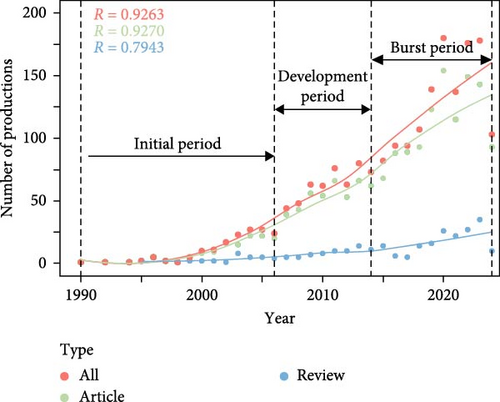
The publication trend can be divided into three phases: i) the initial period (1990–2006), ii) the development period (2007–2014), and iii) the burst period (2015–2024). The initial period saw low research activity, averaging fewer than seven publications per year, with a total of 123 documents. During the development period, the publication counts nearly tripled compared to the previous phase. The burst period witnessed a dramatic rise in research output, contributing 1135 publications, more than double the combined output of the earlier phases. A steady increase was observed between 2006 and 2018, peaking in 2022 with 176 publications, indicative of the growing interest in AMPs for disease resistance in aquaculture.
3.2. Productive Country, Institutions, and Authors
The top five countries by publication volume were China, the United States, India, Thailand, and Japan, each contributing over 50 publications (Figure 3A). Japan was among the earliest contributors, with studies dating back to 1990 (Figure 3B). While the USA led during the initial period, China has seen rapid growth in the past decade. Despite accounting for 48.8% of total publications, China’s presence in the field only began in 2002, with just 17 publications before 2006. (Figure 3B).
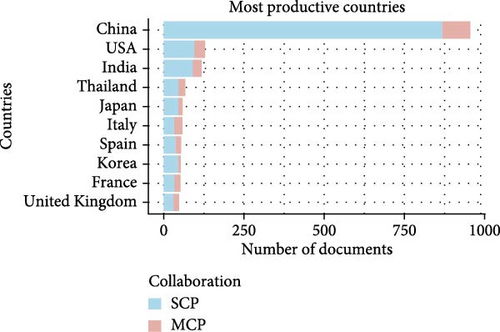
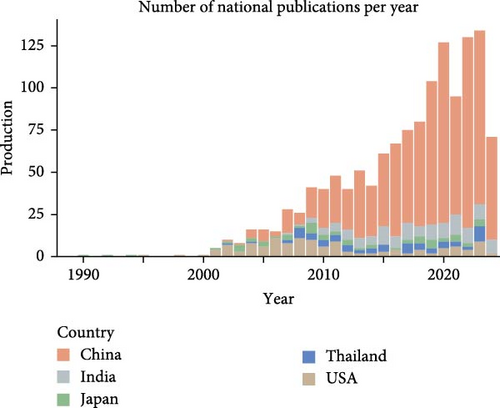
The 10 most productive institutions are listed in Table 2. Nine of these were based in China, and one in France. The Chinese Academy of Sciences (CAS) ranked first with 286 publications, followed by Sun Yat-sen University (189) and Sichuan Agricultural University (164). The Centre National de la Recherche Scientifique (CNRS) in France contributed 106 publications.
| Rank | Affiliations | Country | NP |
|---|---|---|---|
| 1 | Chinese Academy of Sciences | China | 286 |
| 2 | Sun Yat-sen University | China | 189 |
| 3 | Sichuan Agricultural University | China | 164 |
| 4 | Ministry of Agriculture and Rural Affairs of the People’s Republic of China | China | 126 |
| 5 | Xiamen University | China | 119 |
| 6 | Centre national de la recherche scientifique (CNRS) | France | 106 |
| 7 | Academia Sinica, Taiwan | China | 84 |
| 8 | University of Chinese Academy of Sciences, CAS | China | 80 |
| 9 | Chinese Academy of Fishery Sciences | China | 79 |
| 10 | Laoshan Laboratory | China | 79 |
- Abbreviation: NP, number of publications.
An author dominance analysis revealed Liu Yang from the Key Laboratory of Experimental Marine Biology (EMBL), Institute of Oceanology, CAS, China, as the most prolific author, with 61 total publications (Table 3). Of the top 20 authors, 17 were from China, while others were from Thailand, India, and Japan. Anchalee Tassanakajon from Chulalongkorn University was the most cited author (41 total publications and 1017 citations), followed by Chen Jyh Yih from the Institute of Cellular and Organismic Biology, Academia Sinica, Taiwan (47 publications and 846 citations).
| Rank | NP | Name | Country | Rank | NP | Name | Country |
|---|---|---|---|---|---|---|---|
| 1 | 61 | Y. Liu | China | 11 | 40 | J. Jiang | China |
| 2 | 60 | L. Feng | China | 12 | 36 | J. X. Wang | China |
| 3 | 60 | P. Wu | China | 13 | 34 | J. G. He | China |
| 4 | 59 | X. Q. Zhou | China | 14 | 34 | K. J. Wang | China |
| 5 | 56 | W. D. Jiang | China | 15 | 33 | Y. A. Zhang | China |
| 6 | 56 | L. Tang | China | 16 | 29 | R. Philip | India |
| 7 | 54 | S. Y. Kuang | China | 17 | 28 | W. N. Tang | China |
| 8 | 47 | J. Y. Chen | China | 18 | 28 | X. F. Zhao | China |
| 9 | 43 | Q. Ren | China | 19 | 26 | I. Hirono | Japan |
| 10 | 41 | A. Tassanakajon | Thailand | 20 | 24 | C. Z. Li | China |
- Abbreviation: NP, number of publications.
The top 20 most cited publications were listed in Table 4. Generally, the older studies received more citations. Therefore, normalized total citation counts were provided to offer insight into the most influential papers. The most cited article was published by Gross et al. [46] in Developmental and Comparative Immunology, receiving 456 citations. Among the most globally cited reviews, Bergljót Magnadóttir (Fish and Shellfish Immunology, 2006), Anthony E. Ellis (Developmental and Comparative Immunology, 2001), and Guangshun Wang (Nucleic Acids Research, 2009) ranked the top three. These reviews focused on fish innate immune response and the antimicrobial peptide database, respectively.
| Paper | Year | DOI | Type | TC | TC per year | Normalized TC | JCR | IF |
|---|---|---|---|---|---|---|---|---|
| Gross et al., Dev. Comp. Immunol. | 2001 | 10.1016/S0145-305X (01)00018-0 | Article | 456 | 19 | 2.052 | Q1 | 2.7 |
| Cole et al., J. Biol. Chem. | 1997 | 10.1074/jbc.272.18.12008 | Article | 419 | 14.96 | 1.066 | Q2 | 4 |
| Destoumieux et al., J. Biol. Chem. | 1997 | 10.1074/jbc.272.45.28398 | Article | 367 | 13.11 | 0.934 | Q2 | 4 |
| Charlet et al., J. Biol. Chem. | 1997 | 10.1074/jbc.271.36.21808 | Article | 306 | 10.55 | 1.891 | Q2 | 4 |
| Subramanian et al., Comp. Biochem. Physiol. B Biochem. Mol. Biol. | 2007 | 10.1016/j.cbpb.2007.06.003 | Article | 306 | 10.55 | 1.891 | Q1 | 1 |
| Destoumieux et al., J. Biol. Chem. | 2001 | 10.1074/jbc.M103817200 | Article | 291 | 12.12 | 1.309 | Q2 | 4 |
| Shike et al., Eur. J. Biochem. | 2002 | 10.1046/j.1432-1033.2002.02881.x | Article | 282 | 12.26 | 2.231 | Q2 | 3.579 |
| De Clercq et al., Med. Res. Rev. | 2000 | 10.1002/1098-1128(200009)20 : 5 <323::AID-MED1 >3.0.CO;2-A | Article | 276 | 11.04 | 1.964 | Q1 | 10.9 |
| Lauth et al., J. Biol. Chem. | 2002 | 10.1074/jbc.M109173200 | Article | 238 | 10.35 | 1.883 | Q2 | 4 |
| Destoumieux et al., J. Cell. Sci. | 2000 | 10.1242/jcs.113.3.461 | Article | 223 | 8.92 | 1.587 | Q3 | 3.3 |
| Magnadottir et al., Fish Shellfish Immunol. | 2006 | 10.1016/j.fsi.2004.09.006 | Review | 1565 | 82.37 | 12.004 | Q1 | 4.1 |
| Ellis et al., Dev. Comp. Immunol. | 2001 | 10.1016/S0145-305X (01)00038-6 | Review | 932 | 38.83 | 4.193 | Q1 | 2.7 |
| Wang et al., Nucleic Acids Res | 2009 | 10.1093/nar/gkn823 | Review | 689 | 137.8 | 31.059 | Q1 | 16.6 |
| Huan et al., Front. Microbiol. | 2020 | 10.3389/fmicb.2020.582779 | Review | 645 | 29.32 | 5.562 | Q1 | 4 |
| Kitts et al., Curr. Pharm. Des. | 2003 | 10.2174/1381612033454883 | Review | 564 | 43.38 | 8.212 | Q2 | 2.6 |
| Chalamaiah et al., Food Chem. | 2012 | 10.1016/j.foodchem.2012.06.100 | Review | 560 | 26.67 | 4.773 | Q1 | 8.5 |
| Loker et al., Immunol. Rev. | 2004 | 10.1111/j.0105-2896.2004.0117.x | Review | 528 | 44 | 9.327 | Q1 | 7.5 |
| Gomez et al., Fish Shellfish Immunol. | 2013 | 10.1016/j.fsi.2013.09.032 | Review | 509 | 29.94 | 6.819 | Q1 | 4.1 |
| Gomez et al., FEMS Immunol. Med. Microbiol. | 2008 | 10.1111/j.1574-695X.2007.00343.x | Review | 462 | 15.4 | 1.525 | Q2 | 3.078 |
| Maloy et al., Biopolymers | 1995 | 10.1002/bip.360370206 | Review | 564 | 43.38 | 8.212 | Q2 | 3.2 |
3.3. International Collaboration (Geographical Analysis)
Figure 4 illustrates the global collaboration network for aquatic AMP research, with the thickness of lines indicating the degree of cooperation between countries. A total of 52 collaborative entries were identified. China and the USA were the major hubs, establishing connections with collaborators in numerous countries. China engaged in 88 collaborations with 30 countries, most notably with the USA, with a collaborative network value (CNV) of 49, followed by the United Kingdom (CNV of 10), Japan (CNV of 9), and Australia (CNV of 9). It should be noted that China had relatively few collaborations with India, despite India’s position as the world’s third-largest fish producer and third-largest producer of articles in this field. US authors collaborated with researchers from 29 countries across 34 publications. In contrast, most other countries had limited international collaboration, with 12 single collaborations and eight bi-collaborations (two collaborations) between various nations. Eight countries did not engage in any international collaborations.
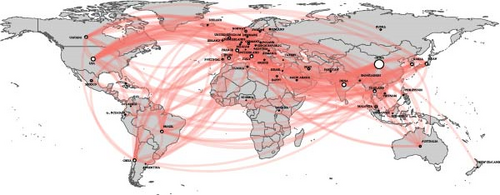
3.4. Trending Topics of Antimicrobial Peptide
Figure 5 presents a Sankey diagram visualizing the thematic evolution of the AMPs research from 1999 to 2024. Keywords duplications were present due to inconsistent usage of words in different literatures. During the initial period, dominant themes included “antimicrobial activity”, “innate immunity”, and “expression profile”. PCR amplification (cDNA cloning) and cDNA library sequencing (expressed sequence tags) have been widely used in discovering new genes and transcripts of AMPs. In the development period (2007–2014), it is clear that the research concept splits up into several themes, including AMP identification in various aquatic animals, antiapoptosis effects, hemolytic, and cytotoxic activities. In the burst period (2015–2024), although publication numbers surged, the research areas are more restricted, reducing from 18 in the period of 2007–2014 to 7 in the 2015–2024 period.
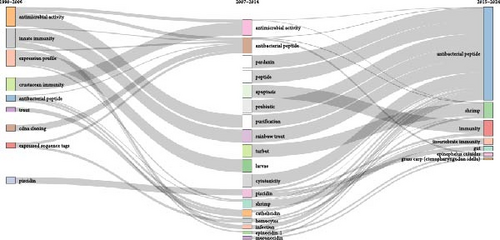
Figure 6 provides thematic maps showing the density and centrality of research clusters within each period. As shown in Figure 6, the clusters on each map varied significantly. In the initial period, “cDNA cloning” and “mass spectrometry” emerged as the basic themes, along with “cDNA library”, “expressed sequence tag (EST)”, which refer to the most basic research methods and research topics in this field. Other notable basic themes, such as “antimicrobial activity”, “mucus”, “purification”, “hemocyte”, and crustaceans, such as “shrimp” form a general foundation for the research field and possess a broad scientific impact. These themes were central to discussions and supported by a substantial volume of research and citations. The themes “teleost”, “innate immunity”, and “expression profile” constituted the motor themes. These topics were relatively important and well-developed within the field, representing the most frequently discussed subjects.
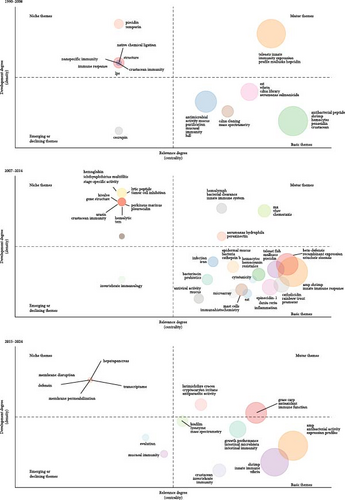
In the second period (2007–2014), the themes became more fragmented. The antiviral potential of AMPs received substantial attention. “antiviral activity” was categorized as a basic theme, while “mx” and “vhsv” were situated within the motor theme. In addition, “cytotoxicity” and “hemocytes” were classified as basic themes during the period, indicating their importance within the field. However, these themes also highlighted potential limitations for the use of AMPs as pharmaceuticals, as they were not yet fully developed. Aquatic pathogenic parasites, such as Ichthyophthirius multifiliis and Perkinsus marinus were classified as niche themes in this period, reflecting targeted research areas exploring the antiparasite function of AMPs. Despite their low centrality at the time, the developmental density of these themes suggests their potential to significantly influence future research directions.
In the final period, themes such as “growth performance”, “intestinal microbiota”, and “intestinal immunity” gained researchers’ interest, reflecting an increased focus on the practical applications of AMPs in aquaculture, including their impact on gut health and growth performance. In addition, “Cryptocaryon irritans”, “Larimichthys crocea”, and “antiparasitic activity” were classified as motor themes, indicating that the antiparasitic function of AMPs has been extensively discussed. For instance, studies have investigated the efficacy of piscidins from Sciaenops ocellatus and Larimichthys crocea against Cryptocaryon irritans [47, 48]. Furthermore, the theme of “evolution” was classified of the emerging themes during this period. This trend can be attributed to the availability of large-scale genome sequencing data, which has facilitated studies focused on modeling evolutionary patterns.
3.5. Keyword Burst
A word cloud analysis was performed to highlight the frequently occurring keywords, reflecting hotspots in research topics and facilitating a deeper understanding of scientific discoveries. The resulting tree plot showed that, in addition to the query terms “antibacterial peptides”, “teleost”, and “shrimp”, the terms “innate immunity”, “expression profile”, and “vibrio” were also frequently mentioned in these publications. Key AMPs, including antilipopolysaccharide factor (ALF), hepcidin, defensin, piscidin, and nk-lysin, were well studied (Figure 7). Some reports also addressed the antiviral, antioxidant, anti-inflammatory, and apoptotic roles of AMPs.
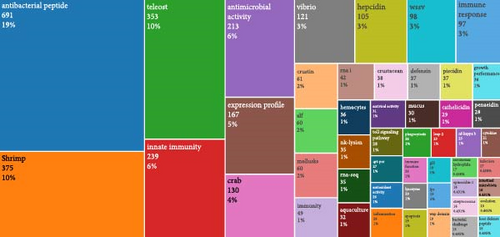
To analyze the evolution of keywords over time, a burst keywords analysis was conducted using CiteSpace. The result largely aligned with the trends depicted in the thematic evolution diagram above (Figure 8). Few bursts were observed in the initial period. “fish” was the earliest burst keyword, appearing from 1996 to 2009. Oren et al.[49] identified pardaxin from moses sole, Pardachirus marmoratus, and characterized its structural features responsible for selective hemolytic and antibacterial activities. Following that, Lemaître et al. [50] isolated two hydrophobic proteins (31 and 27 kDa) from detergent-solubilized carp (Cyprinus carpio) skin mucus, which exhibited strong bactericidal activity (0.018–0.18 μM) against various gram-negative and gram-positive bacteria. Keyword frequency increased markedly from the first to second period, reflecting a growing focus on AMP genes across fish and crustacean species. Researchers were particularly interested in investigating postinfection expression patterns, regulatory mechanisms, and pathogen inhibition efficacy. During the burst period, emerging trends included “disease resistance”, “antibiotics”, “growth performance”, “inflammation”, “antiviral”, and “molecular docking”, indicating sustained research interest in antimicrobial mechanisms and practical applications likely to persist in the coming years.
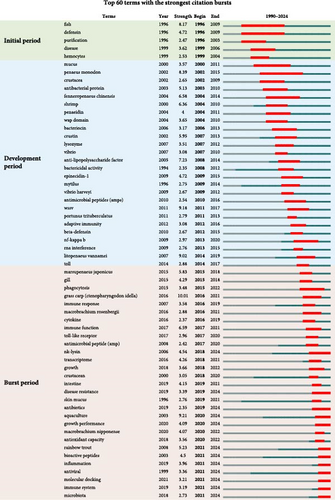
4. Discussion
This study employed a bibliometric analysis to examine the research landscape of AMPs in aquaculture. By analyzing English-language articles published between 1990 and 2024, we generated visualizations to depict publication trends, geographical distribution, author contributions, journal impact, and thematic evolution. These results provide a comprehensive overview of the field’s development, highlight current focal points, and offer direction for future research.
Our analysis reveals a significant rise in aquatic AMP publications since 2010, following a relatively quiet period before 2006. China has emerged as the leading contributor since 2007, accounting for over one-third of all published studies. This prominence can be attributed to several factors, including strong industry demand, increased research funding, and academic expertise, as well as extensive scientific collaborations and interdisciplinary integration [51, 52]. As the world’s largest producer of aquatic products, China has increased its output from 13.54 million tons in 1990 to 71.16 million tons in 2023 (2024; 1991 China Fishery Statistical Yearbook). The country has demonstrated a strong commitment to advancing research across all dimensions of aquaculture [53]. This rapid expansion has heightened the need for sustainable and effective disease control measures, encouraging research into alternatives to conventional antibiotics. Recognizing the threat posed by antimicrobial resistance, the Chinese government launched the National Action Plan for Curbing Bacterial Resistance (2016–2020) in 2016, aimed at optimizing the scientific application of antimicrobials and curbing the development and spread of resistance. Concurrently, the Ministry of Agriculture and Rural Affairs (MARA) introduced frameworks to reduce antibiotic dependance. The 2019 National Action Plan for Aquaculture Drug Reduction emphasized minimizing drug use, improving product quality, and promoting green aquaculture. Reinforcing these goals, the 2020 notice on implementing the “Five Major Actions” for green and healthy aquaculture (document no. 8, MARA Office of Fisheries [2020]) mandated annual reductions of at least 5% in veterinary drug use and 10% in antibiotic usage at pilot sites. These government policies, which prioritize sustainable practices, including antibiotic alternatives, have directly incentivized AMP research and innovation. In addition, China’s centralized research institutions (e.g., CAS, with 286 publications) facilitate interdisciplinary collaboration, enabling rapid translation of discoveries into patents and applications. India, the world’s third-largest fish producer and second-largest aquaculture country, has also made significant progress [54]. Government initiatives, such as Fisheries and Aquaculture Infrastructure Fund (FAIF) in 2006 and the Pradhan Mantri Matsya Sampada Yojana (PMMSY) in 2020, have invested billions of rupees into marine and aquaculture operations, research, and education [55]. These efforts likely contribute to the high productivity of both China and India in AMP-related aquaculture research.
The most cited article in this field was published by Gross et al. [46] in 2001, with 456 citations in the Web of Science Core Database, averaging 19 citations per year. This study reported the sequencing of immune-function ESTs in the Pacific white shrimp, Litopenaeus vannamei, and the Atlantic white shrimp, L. setiferus [46]. Another highly influential article by Cole et al. [56] identified pleurocidin in the skin secretions of winter flounder using multiple chromatographic methods and has received 419 citations. Despite China’s leadership in AMP publication volume, none of the top 10 most-cited papers originates from Chinese authors, and their average citation rates remain relatively low. This suggests a need to enhance the quality and global impact of Chinese research outputs.
In addition, the international cooperation between China and other countries needs to be strengthened. Cross-border cooperation brings together diverse perspectives and expertise, facilitating more innovative and influential research. Despite China’s high output, its relatively low MCP ratio indicates limited international engagement. Strengthening such collaborations would enhance both innovation and the international visibility of Chinese research on AMPs in aquaculture. Although China and India are major fish-producing nations and AMR hotspots [57], collaborative research between them is underdeveloped. One barrier may be language, as most academic journals are published in English, limiting engagement for some non-native speakers and confining much of their research to domestic platforms. This is reflected in China’s MCP ratio of just 9.2%. Another possible reason is the lack of established collaborative networks and communication channels between researchers in these two countries. Shared research infrastructure and funding mechanisms are underdeveloped between China and India, unlike China’s established partnerships with other English-speaking nations such as the U.S. (CNV of 49). The absence or rarity of formal networks for researcher exchange and joint funding programs limits cross-border cooperation. In the future, macrolevel policy guidance and the establishment of long-term mechanisms are required to foster collaboration between scientific institutions in these countries. Such efforts would allow researchers to share complementary expertise and improve research outcomes in the field.
In terms of institutional productivity, approximately 90% of the top 10 most productive institutions are located in China, underscoring the country’s dominant presence. However, these institutions exhibit limited international collaboration, as reflected in a low MCP ratio of 0.0921, far below the 0.305 average observed across the other nine leading countries. This lack of cross-institutional engagement could hinder long-term scientific progress. Therefore, we strongly recommend enhanced cooperation and communication among research institutions globally to support the continued development of aquaculture science [51].
Keyword analysis revealed a thematic shift in the literature, from gene cloning, structural characterization, and function, toward antibacterial mechanisms and applications of AMPs. Although several aquatic AMPs have demonstrated promising in vitro and in vivo activity, their practical application in aquaculture remains limited due to multiple challenges. First, AMP activity is often highly sensitive to environmental conditions, leading to discrepancies between in vitro activity and in vivo efficacy. For example, many marine invertebrate-derived AMPs lose activity under high salinity [58]. The Atlantic cod cathelicidin peptide, while exhibiting potent antifungal and antibacterial activity in low ionic strength medium, becomes inactive at physiological salt concentrations [59]. Nonoxidized form Myticin C from the mussel Mytilus galloprovincialis exhibited no activity against bacteria at physiological pH, but can inhibit E. coli and disrupt phospholipid membranes at low pH [60]. D-Caerin shows enhanced stability and activity compared to its natural L-form, with improved resistance to enzymatic degradation, acidic environments, and high salinity, making it more effective against pathogenic Vibrio species [61].
Second, oral delivery of AMPs to aquatic animals is difficult due to their susceptibility to degradation and rapid clearance. While some studies report improved growth, immunity, and survival when AMPs are used as feed additives, their effects are various. Oral efficacy can be affected by various factors, such as reactivity with the aquatic environment, leakage from pellets, floating time of pellets, and poor palatability of medicated food [62]. For example, Lin et al. [63] reported that dietary supplementation of cecropin improved growth performance and feed conversion efficiency but reduced feed intake. Orally administered AMPs must survive digestive enzymes and reach target tissues in adequate quantities, often requiring higher dosages [64, 65].
Third, high production costs present another major barrier to AMP adoption. Current production methods include biological extraction, chemical synthesis, and genetic engineering [66]. Direct extraction is inefficient and unsuitable for mass production due to low natural yields and high purification losses. Chemical synthesis, while improving production efficiency, remains expensive [67]. Genetic engineering in vitro synthesis technology offers a scalable and cost-effective alternative but faces expression challenges in bacterial systems [68]. To address these limitations, future research should focus on improving existing methods or developing new peptide synthesis techniques to reduce production costs. Ultrashort or truncated peptides, with shorter amino acid sequences, may offer a promising solution to reduce manufacturing costs while retaining antimicrobial efficacy [69, 70].
5. Conclusions
This bibliometric analysis reveals the current state and increasing research interest in aquatic AMPs. China has emerged as a leading contributor in this field. Our keyword and thematic analyses indicate a shifting research focus on the antibacterial mechanisms and practical applications of aquatic AMPs. To promote the use of AMPs in aquaculture as a strategy against antibiotic-resistant bacterial infections, stronger international collaboration among researchers is essential.
Conflicts of Interest
The authors declare no conflicts of interest.
Author Contributions
Meihua Zhu and Yangping Liu contributed equally to this study.
Funding
The publication cost of this article is supported by the Natural Science Foundation of Fujian Province (Grant 2021J02047) and the National Natural Science Foundation of China (Grants 32073011 and 32373163).
Supporting Information
Additional supporting information can be found online in the Supporting Information section.
Open Research
Data Availability Statement
The data that support the findings of this study are available from the corresponding author upon reasonable request.




